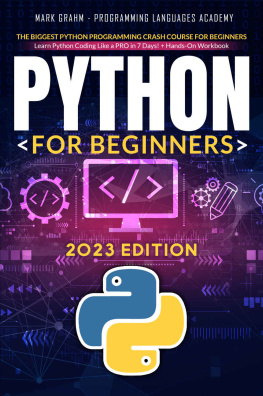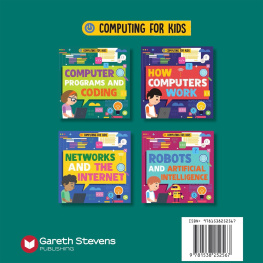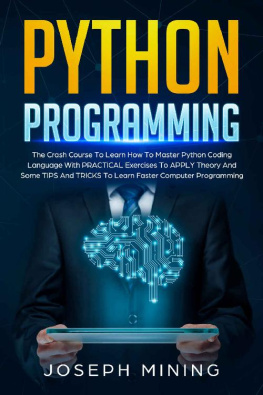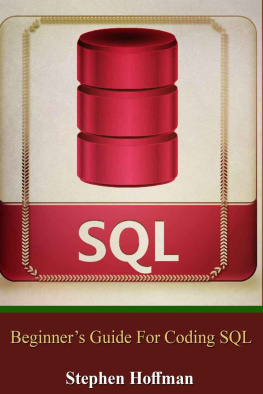Michail Klling
Computer Programming
The Most Complete Crash Course for Learning The Perfect Skills To Coding Your Project Even If You Are an Absolute Beginner. Learn and Master The Best Programming Languages!
Copyright 2021 by Michail Klling
All rights reserved. No part of this publication may be reproduced, stored or transmitted in any form or by any means, electronic, mechanical, photocopying, recording, scanning, or otherwise without written permission from the publisher. It is illegal to copy this book, post it to a website, or distribute it by any other means without permission.
First edition
This book was professionally typeset on Reedsy
Find out more at reedsy.com
Contents
I
PYTHON PROGRAMMING FOR BEGINNERS
After work guide to start learning Python on your own. Ideal for beginners to study coding with hands on exercises and projects for a new possible job career.
Introduction
The Python coding language is a great way to start your journey by learning more about computers, learning how to code, and even making some of your games and apps. This is one of the best languages to get started because it is simple, based on the English language, and many of those who decide to get started with a coding language will naturally fall with this one. This guidebook is going to take some time to discuss the Python language and help you to learn some of the basics that come with it to help you to get started.
While the Python language is a simple and basic language that is perfect for the beginner, it also has a lot of power that you are going to enjoy when creating your codes. Inside this guidebook, you are going to learn everything that you need to get started with the Python language and to make it work well for your needs!
This book is primarily for people who are relatively new to programming and, more specifically, those who want to discover the world of Python. This book will take you through the fundamentals of programming and Python.
Computer programming sounds scary, but it really isnt. The hardest part is choosing which language you want to learn because there are so many to choose from. Python is one of the easiest of all of computer programming languages; indeed, pretty much everything you need is right there, at your disposal. All you need to do is learn how to use what the program gives you to write programs.
Go ahead and read through the entire book, get the knowledge, and be informed about the key things that you need to know about this particular topic.
If you are as excited as I am to learn everything Python and how to program with it, let us get started.
Chapter 1: Datatype in python
The Python Data Types
The next thing that we need to take a look at is the Python data types. Each value in Python has a type of data.
Python numbers
The first option that we can work on Python data includes the Python numbers. These are going to include things like complex numbers, floating-point numbers, and even integers. They are going to be defined as complex, float, and int classes in Python. For example, we can work with the type() function to identify which category a value or a variable affiliated with to, and then the isinstance() function to audit if an object exists to a distinct class.
When we work with integers can be of any length, it is going only to find limitations in how much memory you have available on your computer. Then there is the floating-point number.
This is going to be accurate up to 15 decimal places, though you can go with a smaller amount as well.
The floating points are going to be separated by a decimal point. 1 is going to be an integer, and 10 will be a floating-point number.
And finally, we have complex numbers. These are going to be the numbers that we will want to write out as x + y, where x is going to be the real point, and then they are going to be the imaginary part.
We need to have these two put together to make up the complexity that we need with this kind of number.
Python lists
The Python list is going to be a regulated series of items. It is going to be one of the data types that are used the most in Python, and it is exceedingly responsive.
All of the items that will show up on the list can be similar, but this is not a requirement. You can work with a lot of different items on your list, without them being the same type, to make it easier to work with.
Being able to declare a list is going to be a straightforward option that we can work with. The items are going to be separated by commas, and then we just need to include them inside some brackets like this: [ ] we can also employ the slicing operator to help us obtain out a piece or a selection of items out of that list.
The index starts at 0 in Python.
And we have to remember while working on these that lists are going to be mutable.
It means that the value of the elements that are on your list can be altered or updated.
The lists in Python are going to be the most basic data structure because they are going to fall in a sequence.
The elements that are inside of the list are all going to have a number that is assigned to them. In other words, they all have a place that is assigned to them.
Not only are they simple, but lists are going to be versatile.
When creating a list, the objects are going to be separated by a comma, and all of these objects are going to fall inside a set of square brackets.
Items in a list are not going to have to be of the same data type.
Example
First list = [ science, history, , 2002, 2030 ] ;
Second list = [ 2, 4, 6 ,8 ,10 ];
Third list = [ b, d, e, g ]
The index for a list is going to start at zero, and you are going to have the ability to cut it so that you can create sub lists Getting values inside of your list
When you want to get a value inside of the list so that you can slice it at a specific index.
Example
#! usr bin/ python
First list = [ science, history, , 2002, 2030 ] ;
Second list = [ 2, 4, 6 ,8 ,10 ];
Print first list [ 2 ] : , fist list [ 2 ]
Print second list [ 2:4 ] : , second list [ 2 : 4 ]
Output
First list [ 2 ]: history
Second list [ 2:4 ] : [ 4, 6, ]
Python Strings
Python strings are a series of characters enclosed within quotes. Use any type of quotes to enclose Python strings, that is, either single, double, or triple quotes. To access string elements, we use the slice operator. String characters begin at index 0, meaning that the first character string is at index 0. This is good when you need to access string characters. To concatenate strings in Python, we use + operator, the asterisk 9*) is used for repetition. Example:
#!usrbin/python3
thanks = Thank You
print (thanks) # to print the complete string
print (thanks[0]) # to print the first character of string
print (thanks[2:7]) # to print the 3rd to the 7th character of string
print (thanks[4:]) # to print from the 5th character of string
print (thanks * 2) # to print the string two times
print (thanks + \tAgain!) # to print a concatenated string
The program prints the following once executed:









